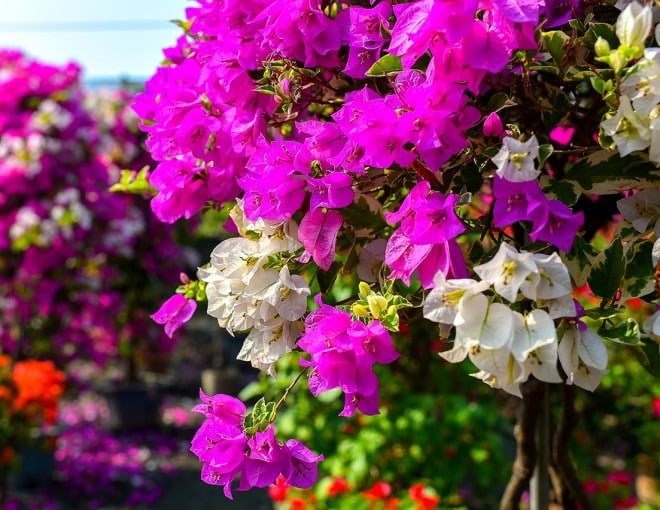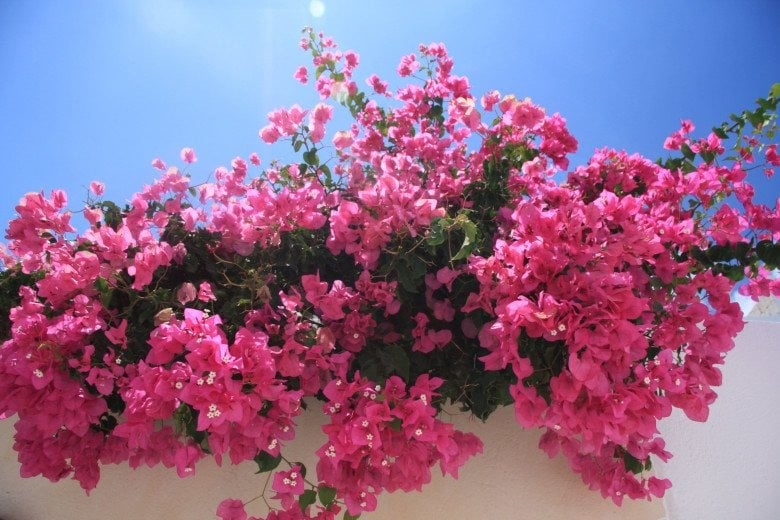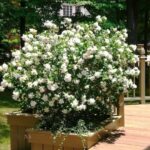Bougainvillea, or more commonly known as paper flowers, are a popular choice for many gardeners. But not everyone knows which elements in Feng Shui favor this plant and the ideal location to grow them. Paper flowers can be potted on balconies, rooftops, or shaped into bonsais, flower walls, or flower trellises.
This flower is beloved for its year-round bloom and vibrant colors of red, purple, yellow, orange, and pink, as well as its varied growth patterns. Bougainvillea is easy to grow and does not require much maintenance.

Bougainvillea is low-maintenance and easy to grow.
In Vietnam, there are six most beautiful and popular types of bougainvillea: Bougainvillea Glabra, Wan Hoa Lau bougainvillea, Cowboy bougainvillea, American bougainvillea, Marble bougainvillea, and Thai bougainvillea. However, not many people know exactly which Feng Shui elements favor this plant and the best location to grow it.
Is it suitable to plant bougainvillea in front of the house?
This is a question many people ask when choosing a location to grow bougainvillea. According to Feng Shui, the area in front of the house is where the fortune and positive energy of the owner are attracted. If this area is not favorable or decorated with inappropriate objects, it could hinder the flow of fortune into the house and bring bad luck.
Bougainvillea, in Feng Shui, symbolizes abundance, protection, and complete happiness. With its bright colors, bougainvillea represents luck and wealth. It is also believed to have the ability to ward off evil spirits and prevent bad things from happening, bringing peace and happiness to the family. Bougainvillea also symbolizes lasting love and harmonious marriage.
With these positive meanings, planting bougainvillea in front of the house can bring good luck and fortune to the owner, while also creating a peaceful and happy family.

Bougainvillea symbolizes abundance, protection, and happiness in Feng Shui.
From a scientific perspective, planting bougainvillea in front of the house not only beautifies the landscape but also helps filter dust, purifies the air, and protects the health of family members. It can also provide shade for your home.
However, bougainvillea should not be planted in the middle of a pathway as it will obstruct the flow of positive energy into the house. If the area in front of the house does not receive ample sunlight or is not well-ventilated, it is also not advisable to plant bougainvillea as this plant thrives in sunny and airy environments.
The recommendation is to plant bougainvillea on both sides of the house gate, preferably in pairs, to create a symmetrical balance of Yin and Yang and beautify the entrance. Alternatively, you can also plant bougainvillea in the yard, balcony, or living room, as long as these areas receive sufficient sunlight and airflow for the plant to grow well.
Which Feng Shui element benefits the most from planting bougainvillea?
Bougainvillea, with its positive Feng Shui symbolism, is suitable for all five elements of the Chinese philosophy but is especially beneficial for those of the Earth element. People of the Earth element who plant bougainvillea often experience smoother careers, stable lives, and overall good fortune, never lacking financially.
For other elements, when planting bougainvillea, choose a color that corresponds to your element. For example, those of the Metal element can choose white or yellow bougainvillea, while those of the Fire element usually match with colors like pink, red, orange, yellow, or purple.
Additionally, bougainvillea is particularly favorable for people born in the years of the Tiger, Dragon, and Snake. Planting bougainvillea in front of the house for these individuals can attract good luck, fortune, and a prosperous life.
Why Did Ancestors Fear Planting Tall Trees in Front of Their Houses and Having Windows at the Back?
The ancient belief that planting tall trees in front of a house and keeping the back windows open would bring harm to the household is a fascinating one. Superstition or not, this practice has been passed down through generations, with many believing it to hold some truth. This intriguing concept sets the tone for a captivating exploration into the world of ancient traditions and their modern-day interpretations.



































